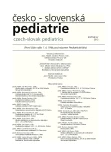The effect of thumb sucking on splanchocraniums development in childhood
Authors:
J. Lysý 1; Z. Lysá 2; B. Suchancová 1; A. Thurzo 1; O. Červeňová 2
Authors‘ workplace:
Klinika stomatológie a maxilofaciálnej chirurgie LFUK a OÚSA, Bratislava, prednosta doc. MUDr. P. Stanko, PhD., 1. Detská klinika LFUK a DFNsP, Bratislava , prednosta doc. MUDr. O. Červeňová, CSc.
1
Published in:
Čes-slov Pediat 2012; 67 (1): 43-47.
Category:
Case Report
Overview
Thumb sucking is one of the most common bad habits in childhood. Its prevalence varies between 10 and 34 % in developed countries. In case of long persistence, mainly during the mixed dentition period and high intensity, structures of developing splanchnocranium may be influenced. Thumb sucking is associated with higher prevalence of upper incisor protrusion, open bite and upper dental arch compression. If the intensity of thumb sucking is extreme high, symptomatology of sagittal skeletal maxillary growth stimulation can be observed in rare cases.
Authors of this paper are presenting three cases reports with typical clinical symptomatology of splachnocraniums growth changes associated with thumb sucking.
Key words:
thumb sucking, orthodontic anomaly, open bite, incisor protrusion
Sources
1. Davidson L. Thumb and finger sucking. Pediatr Rev 2008 Jun; 29 (6): 207–208.
2. Kantorowicz A. Die Bedeutung des Lutschens für die Entstehung erworbener Fehlbildungen. Fortschritte der Kieferorthopädie 1955; 16 (2): 109–121.
3. Moimaz SA, Zina LG, Saliba NA, Saliba O. Association between breast-feeding practices and sucking habits: a cross-sectional study of children in their first year of life. J Indian Soc Pedod Prev Dent 2008 Sep; 26 (3): 102–106.
4. Heimer MV, Tornisiello Katz CR, Rosenblatt A. Non-nutritive sucking habits,dental malocclusions, and facial morphology in Brazilian children: a longitudinal study. Eur J Orthod 2008 Dec; 30 (6): 580–585.
5. Singh SP, Utreja A, Chawla HS. Distribution of malocclusion types among thumb suckers seeking orthodontic treatment. J Indian Soc Pedod Prev Dent 2008; 26 (Suppl 3): S114–117.
6. Duncan K, McNamara C, Ireland AJ, Sandy JR. Sucking habits in childhood and the effects on the primary dentition: findings of the Avon Longitudinal Study of Pregnancy and Childhood. Int J Paediatr Dent 2008 May; 18 (3): 178–188.
7. Warren JJ, Slayton RL, Bishara SE, Levy SM, Yonezu T, Kanellis MJ. Effects of nonnutritive sucking habits on occlusal characteristics in the mixed dentition. Pediatr Dent 2005 Nov-Dec; 27 (6): 445–450.
8. Proffit WR, Fields HW, Sarver DM. Contemporary Orthodontics. Elsevier, 2007: 145–158.
9. Silk H. Making oral health a priority in your preventive pediatric visits. Clin Pediatr (Phila) 2010 Mar; 49 (2): 103–109.
10. Roberts WE. Bone physiology, metabolism, and biomechanics in orthodontic practice. In: Graber TM, Vanarsdall R, Vig KWL (eds). Orthodontics: Current Principles and Techniques. 4th ed. St. Louis: Elsevier, 2005.
11. Yokota R, Mishiro M, Abe T, Miyake A, Shiina N, et al. Pressure on anterior region of palate during thumb-sucking. Bull Tokyo Dent Coll.2007 May; 48 (2): 57–66.
12. Urbanova W. Dumlání – nevinný zlozvyk nebo velký problém? Stomateam 2011; 11 (1): 13–17.
Labels
Neonatology Paediatrics General practitioner for children and adolescentsArticle was published in
Czech-Slovak Pediatrics

2012 Issue 1
- What Effect Can Be Expected from Limosilactobacillus reuteri in Mucositis and Peri-Implantitis?
- The Importance of Limosilactobacillus reuteri in Administration to Diabetics with Gingivitis
Most read in this issue
- When to search for inhereted thrombophilia risk factors in children?
- Influenced pain by children dental treatment
- The effect of thumb sucking on splanchocraniums development in childhood
- Thymidin kinase – suitable marker for diagnostics and follow up in childhood leukemia
